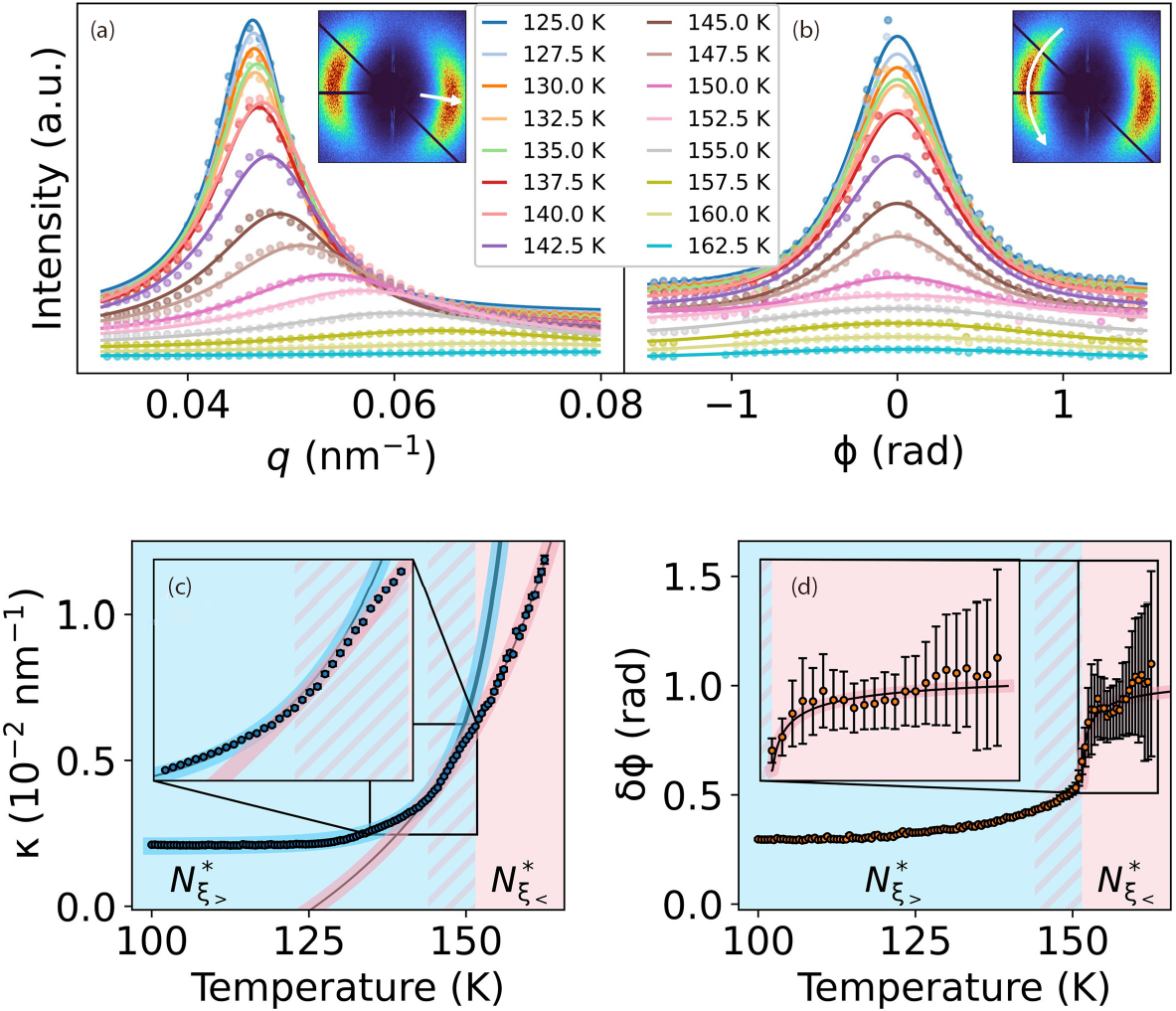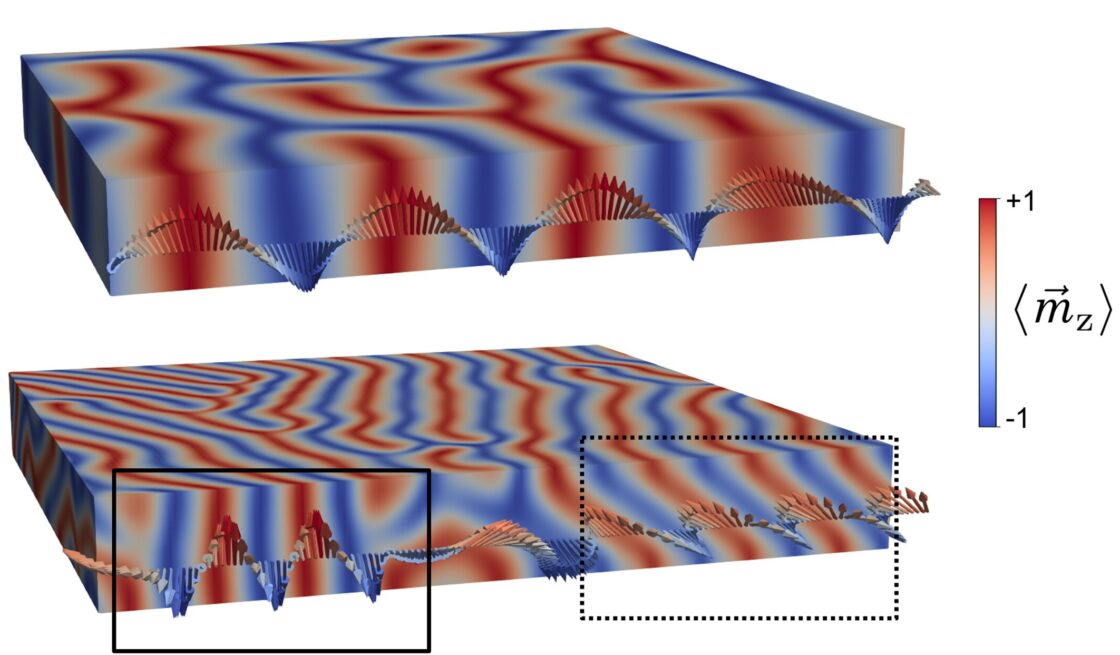SCIENTIFIC ACHIEVEMENT
Experiments at the Advanced Light Source (ALS) produced the first evidence of an exotic nematic phase made up of magnetic helices fluctuating at different timescales.
SIGNIFICANCE AND IMPACT
The findings could advance the development of low-power microelectronic and spintronic technologies.

A dynamic new thin film
In recent years, iron germanium has gained scientific interest because it can host skyrmions—swirling patterns of magnetism that can move through a material without dissipating energy. At room temperature, skyrmions are stable and provide high potential for low-power magnetic computing by replacing magnetic grains in hard drives for data storage or by serving as components in neuromorphic computing.
A team of researchers at the ALS continued with their past studies of iron germanium thin films to examine their stability in a nematic phase—a state of matter where the constituents are spaced irregularly but align in a preferred direction. The researchers explored the nature of the ordering in this material, which resulted in the first experimental evidence of two nematic helical phases with distinct thermodynamics, opening new opportunities to understand the stability of a material that could improve computer performance.
Imaging a complex thin film
Helical magnetism is more difficult to study, because many techniques measure the magnetic moment of a material and for helical materials the magnetic moment averages to zero. Diffraction allows researchers to capture the periodicity of the twist in this less common type of magnetism. The researchers deposited the amorphous iron germanium using DC magnetron co-sputtering. At Beamline 7.0.1.1 (COSMIC Scattering) at the ALS, the team used resonant and coherent x-ray scattering to determine the arrangement and motions of the magnetic coils in the film.
Resonant soft x-ray scattering (RSoXS) is sensitive to static magnetic structure and spatial correlation length (the spatial extent of disorder at a given point in time). X-ray photon correlation spectroscopy (XPCS) is used to study the dynamic processes within materials—including particle diffusion, structural rearrangements, and phase separation—over a wide range of time scales. The technique uses the coherence of x-rays to enable time-dependent measurements within disordered, heterogeneous materials. The team complemented their study using two-pulse x-ray correlation experiments at the Linac Coherent Light Source at SLAC National Accelerator Laboratory to measure faster timescale fluctuations within the material.
Helical coils fluctuate at two tempos
In this study, the team discovered that temperature induces a phase change within the nematic thin film. They determined that at low temperature, the magnetic spins are arranged into coils pointing in relatively the same direction. As heat is applied, the magnetic coils fluctuate on different timescales—one being a trillion times faster than the other. The research team attributed this observation to defects—small disturbances in the helical order—that move independently through the slower, more uniformly oriented system. This heterogeneity in timescale offers the first glimpse of the intricate motions in this complex material.
The researchers fit mathematical models to the x-ray data to understand the nature of the dynamics and performed computer simulations to understand the system. Using this approach, they have found constrained motion of defects at lower temperature that move more freely upon heating, contributing to the multiple timescales observed during the study.
The results provide a framework for characterizing exotic phases, which may have interesting optical and transport properties for microelectronics and spintronics. While this nematic phase requires further study, the discovery could one day lead to the use of a nematic thin film in technologies with on-demand properties based on tiny magnetic helices rather than conventional magnetic materials.

Contacts: Sujoy Roy and Zoey Tumbleson
Researchers: Z. Tumbleson, D. Raftrey, and P. Fischer (Berkeley Lab and University of California, Santa Cruz); S.A. Morley, A. Us Saleheen, M.R. McCarter, and S.D. Kevan (ALS); E. Hollingworth and F. Hellman (Berkeley Lab and University of California, Berkeley); A. Singh (Berkeley Lab and Argonne National Laboratory); T. Bayaraa, R.J. Pandolfi, and S.M. Griffin (Berkeley Lab); N.G. Burdet, V. Esposito, T.A. Assefa, and J.J. Turner (SLAC National Accelerator Laboratory (SLAC) and Stanford); G.L. Dakovski, F.J. Decker, and A.H. Reid (SLAC) and S. Roy (ALS and University of California, Santa Cruz)
Funding: Materials Sciences and Engineering Division and Scientific User Facilities Division, US Department of Energy, Office of Science, Basic Energy Sciences program (DOE BES); Laboratory Directed Research and Development Program (Berkeley Lab); and Center for Advanced Mathematics for Energy Research Applications (CAMERA) program, DOE BES and DOE, Office of Science, Advanced Scientific Computing Research program. Operation of the ALS and Linac Coherent Light Source are supported by DOE BES.
Publication: Z. Tumbleson, S.A. Morley, E. Hollingworth, A. Singh, T. Bayaraa, N.G. Burdet, A. Us Saleheen, M.R. McCarter, D. Raftrey, R.J. Pandolfi, V. Esposito, G.L. Dakovski, F. Decker, A.H. Reid, T.A. Assefa, P. Fischer, S.M. Griffin, S.D. Kevan, F. Hellman, J.J. Turner, and S. Roy, “Thermodynamic phase transitions of nematic order in magnetic helices,” Science Advances 11, eadt5680 (2025). doi: 10.1126/sciadv.adt5680
ALS SCIENCE HIGHLIGHT #530